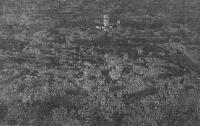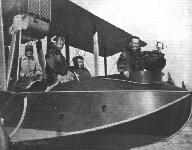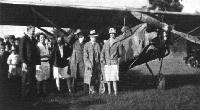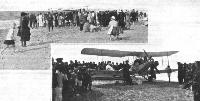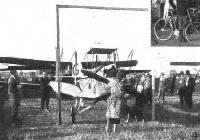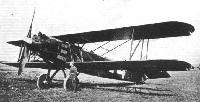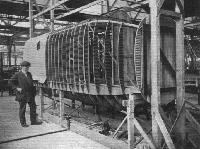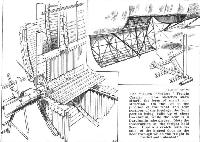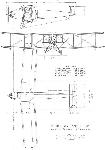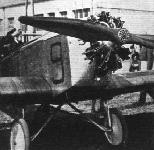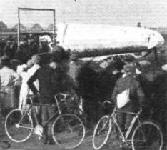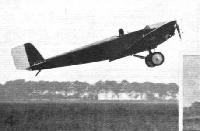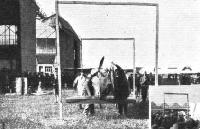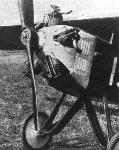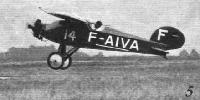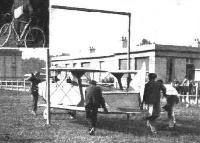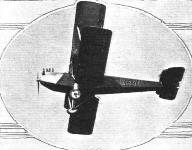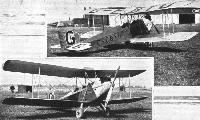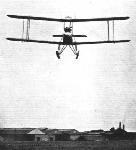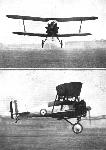Фотографии
-
Регистрационный номер: G-EBTS, H-NADK "Princess Xenia," the Fokker monoplane, fitted with a Bristol "Jupiter," which made the India - England flight.
Самолёты на фотографии: Fokker F.VII / C-2 / F.XIV - Нидерланды - 1924
-
Регистрационный номер: H-NAFA THE AMSTERDAM-BATAVIA AIR MAIL: Five Armstrong Siddeley "Lynx" engined Fokker VII-3m monoplanes lined up on Schipol aerodrome, Amsterdam, for inspection by Dutch Government officials prior to their departure for Batavia.
Самолёты на фотографии: Fokker F.VII / C-2 / F.XIV - Нидерланды - 1924
-
Royal Canadian Air Force Flying-Boat, Northern Manitoba.
Самолёты на фотографии: Vickers Viking / Type 54 - Великобритания - 1919
-
Mapping Timber Types, Eastern Manitoba.
Самолёты на фотографии: Vickers Viking / Type 54 - Великобритания - 1919
-
Photographic Flying-Boat and Crew, Royal Canadian Air Force.
Самолёты на фотографии: Vickers Viking / Type 54 - Великобритания - 1919
-
Регистрационный номер: G-EBOU One of the memories of the Orly meeting for the French and Germans (to judge from their impressions) will be of the stunting display of Flying-Officer Atcherley on the Genet-Moth, the first of that type ever constructed. (Inset left) Flying-Officer Atcherley, and (inset right) shows the machine in a slow roll, whilst in the centre is evidence of the reception he got after the display.
Самолёты на фотографии: De Havilland Moth / D.H.60 - Великобритания - 1925
-
FOLDING TESTS AT ORLY: Our machines showed superiority in the folding tests at the French Light 'Plane Trials. (2) Capt. H. Broad was not quite broad enough for his task. Assisting him is Mr. St. John Plevins.
Самолёты на фотографии: De Havilland Moth / D.H.60 - Великобритания - 1925
-
Регистрационный номер: G-EBYY THE AUTOGIRO IN THE ISLE OF WIGHT: On August 29 Don. J. de la Cierva paid a visit in the Autogiro to Seaview, I.O.W., where he landed on the sands at low tide, causing considerable interest amongst the visitors. He had tea with Mr. Wallace Barr, who was given a "flip" in the machine, and to whom we are indebted for the above snapshots.
Самолёты на фотографии: Cierva/Avro C.8 / C.9 - Великобритания - 1926
-
In this picture are (left to right) Mr. B. J. Hanstock, of the Anglo-American Oil Co., Ltd., Mrs. St. J. Plevins, Mr. "Harold Brooklyn," D.S.O., and Lord and Lady Blyth. The occasion was the landing of Mr. "Brooklyn" in his Westland "Widgeon" in a field near the house of Mr. St. J. Plevins, of the Anglo-American Oil Co., Ltd., followed by luncheon with the latter.
Самолёты на фотографии: Westland Widgeon - Великобритания - 1924
-
Регистрационный номер: J9237 THE WESTLAND WAPITI with Jupiter Engine. A "General Purposes" machine as supplied to the Royal Air Force and R.A.A.F. Suitable for reconnaissance, bombing, wireless, photography, etc. Fitted with Handley-Page Automatic Slot Gear; all-metal construction.
Самолёты на фотографии: Westland Wapiti - Великобритания - 1927
-
Регистрационный номер: G-CAGO CANADIAN COMMERCIAL AIRCRAFT: A Fokker "Universal" monoplane as used by Western Canada Airways.
Самолёты на фотографии: Fokker/Atlantic F.9 Universal / F.18 / F.XI Super Universal - США - 1926
-
Регистрационный номер: G-EBYR [2] TAKING OFF AT ORLY: (1) The Avro "Avian" (Cirrus) flown by Capt. Percival.
Самолёты на фотографии: Avro Avian / Type 594/616 - Великобритания - 1926
-
Регистрационный номер: G-EBYR [2] SUCCESSFUL COMPETITORS IN THE 1928 ORLY MEETING: Herr R. Lusser (left) won with 1,691 points on the Klemm (Salmson) machine shown above him. Capt. E. W. Percival (centre) was second with 1,606 points on the Avro "Avian" (Cirrus Mk. III) (above); and Capt. H. Broad (right) third with 1,581 points on the Gipsy-Moth (above).
Самолёты на фотографии: Avro Avian / Type 594/616 - Великобритания - 1926Daimler L 20 - Германия - 1924De Havilland Gipsy Moth / Moth X - Великобритания - 1928
-
RELIABILITY TRIAL: These are pictures of events during Lady Heath's forced landing on the beach at Trouville in the Avro "Avian." The landing cost her 60 points, for she did not reach Le Havre until the next day.
Самолёты на фотографии: Avro Avian / Type 594/616 - Великобритания - 1926
-
FOLDING TESTS AT ORLY: Our machines showed superiority in the folding tests at the French Light 'Plane Trials. (4) Lady Heath guides her Avro "Avian" safely through in the best time, with Capt. Percival (left) helping.
Самолёты на фотографии: Avro Avian / Type 594/616 - Великобритания - 1926
-
THE GEARED BRISTOL "JUPITER" AT HOME: The Series VIII geared engine which, installed in a Bristol "Bloodhound" biplane, successfully accomplished a 150-hrs.' flying test
Самолёты на фотографии: Bristol Bloodhound / Type 84 - Великобритания - 1923
-
Регистрационный номер: F-AITI [2] M. Finat's Caudron monoplane which he got off in the shortest distance during the take-off tests (91 metres).
Самолёты на фотографии: Caudron C.109 / C.110 - Франция - 1925
-
Регистрационный номер: F-AITI [2] TAKING OFF AT ORLY: (3) The Caudron (Salmson) monoplane, piloted by M. Finat.
Самолёты на фотографии: Caudron C.109 / C.110 - Франция - 1925
-
The Geared Bristol "Jupiter" Abroad: The Czecho-Slovak "Smolik" S.16 biplane which, fitted with a geared "Jupiter," obtained the first prize in the Petite-Entente competition for reconnaissance or day bombing machines adopted by the air services of Jugo-Slavia, Roumania, Czecho-Slovakia and Poland.
Самолёты на фотографии: Letov S-16 - Чехословакия - 1926
-
The Canadian Vickers "Vedette" flying-boat, used for Forest Patrol and Air Photography.
Самолёты на фотографии: Canadian Vickers Vedette - Канада - 1924
-
THE PORTUGUESE FLIGHT TO AFRICA: Four Vickers "Valparaiso" (Napier "Lion") biplanes of the Portuguese Military Air Service, the type on which Capts. Pais Ramos and Oliveira Viegas are flying from Lisbon to Mozambique via Portuguese Guinea and Angola.
Самолёты на фотографии: Vickers Vixen / Venture / Valparaiso / Valiant - Великобритания - 1923
-
Регистрационный номер: G-EBPY ENGLAND-ROUMANIA IN A VICKERS' "VIVID": In connection with some demonstration flights given by aircraft firms of various countries to the Roumanian Government, a splendid flight was made by Flight-Lieut. J. Scholfield on a Vickers "Vivid" long distance Reconnaissance machine (Napier "Lion") shown here. Leaving Weybridge just before 6 a.m. on September 6, he passed over Brussels 18 mins. later and landed at Nuremberg at 9.55 a.m. After a short stop he proceeded over Austria-Hungary to Belgrade (2.55 p.m.) and reached Bucharest at 5.55 p.m. (E.S.T.) ; thus covering over 1,300 miles in 10 hours.
Самолёты на фотографии: Vickers Vixen / Venture / Valparaiso / Valiant - Великобритания - 1923
-
In Course of Construction: This photograph shows the front portion of the fuselage and gives a good idea of the type of metal construction employed.
Самолёты на фотографии: Vickers Vellore / Vellox - Великобритания - 1928
-
The Vickers "Vellore": Photograph of one of the all-metal wings.
Самолёты на фотографии: Vickers Vellore / Vellox - Великобритания - 1928
-
THE VICKERS "VELLORE" FREIGHT CARRIER: Three-quarter rear view. Note the biplane tail and the four rudders. The man standing next to the machine gives a good idea of the size.
Самолёты на фотографии: Vickers Vellore / Vellox - Великобритания - 1928
-
The Vickers "Vellore": Sketch showing the type of Duralumin rib used instead of drag struts. This rib also carries the Bristol-Frise aileron hinge.
Самолёты на фотографии: Vickers Vellore / Vellox - Великобритания - 1928
-
The Vickers "Vellore" Freight Carrier: These sketches show clearly the form of metal construction. On the left is the junction of the front and rear portions of the fuselage, the front portion being built up of sheet Duralumin, while the rear is a Duralumin tube girder. Note the construction of the freight hold floor. Inset is a sketch, with details, of the hinged door in the floor through which the freight is loaded and unloaded.
Самолёты на фотографии: Vickers Vellore / Vellox - Великобритания - 1928
-
Vickers "Vellore" Bristol "Jupiter IX" Engine
Самолёты на фотографии: Vickers Vellore / Vellox - Великобритания - 1928
-
CANADIAN COMMERCIAL AIRCRAFT: A Curtiss flying-boat which was employed by the Fairchild Air Transport on the Haileybury and Rouyn service.
Самолёты на фотографии: Aeromarine AMC - США - 1923
-
Showing the Salmson 40 h.p. engine in the Klemm-monoplane, which has brought Herr Lusser provisionally top of the competition.
Самолёты на фотографии: Daimler L 20 - Германия - 1924
-
FOLDING TESTS AT ORLY: Our machines showed superiority in the folding tests at the French Light 'Plane Trials. (3) The Klemm-Daimler
Самолёты на фотографии: Daimler L 20 - Германия - 1924
-
TAKING OFF AT ORLY: (4) The Klemm (Salmson) flown by Herr Lusser.
Самолёты на фотографии: Daimler L 20 - Германия - 1924
-
FOLDING TESTS AT ORLY: Our machines showed superiority in the folding tests at the French Light 'Plane Trials. (1) The Albert monoplane passing through the posts.
Самолёты на фотографии: Albert TE.1 / R.100 - Франция - 1926
-
Cowling arrangement of the Walter 60 h.p. engine in an Albert monoplane.
Самолёты на фотографии: Albert TE.1 / R.100 - Франция - 1926
-
Регистрационный номер: F-AIVA [2] The Albert monoplane (Salmson), a single seater, covered entirely with three-ply which gained it 15 points immediately.
Самолёты на фотографии: Albert TE.1 / R.100 - Франция - 1926
-
Регистрационный номер: F-AIVA [2] TAKING OFF AT ORLY: (5) The neat little Albert (Salmson) monoplane flown jointly by M. Magnard and M. Fisbach.
Самолёты на фотографии: Albert TE.1 / R.100 - Франция - 1926
-
FOLDING TESTS AT ORLY: Our machines showed superiority in the folding tests at the French Light 'Plane Trials. (5) Flight-Lieut. "Nick" Comper carries on in spite of his disheartening troubles with the C.L.A.4
Самолёты на фотографии: Comper Cranwell IV / CLA.4 - Великобритания - 1926
-
Регистрационный номер: G-EBYU [2] The Simmonds' "Spartan" in low flight over Croydon Aerodrome on September 3, when it was demonstrated by Mr. O. E. Simmonds and Capt. N. Stack.
Самолёты на фотографии: Simmonds Spartan - Великобритания - 1928
-
Регистрационный номер: G-EBYU [2] Two views of Simmonds "Spartan" ("Cirrus" Mk. III) fitted with Fairey metal airscrew, which is distinctive for its interchangeability of wings, of rudder with elevators, and of fin with tail plane sections.
Самолёты на фотографии: Simmonds Spartan - Великобритания - 1928
-
Mr. O. E. Simmonds, the designer of the Simmonds' Spartan ("Cirrus" Mk. III), who is also a qualified pilot.
Самолёты на фотографии: Simmonds Spartan - Великобритания - 1928
-
This front view of the "Spartan" light 'plane in flight shows in particular the split axle.
Самолёты на фотографии: Simmonds Spartan - Великобритания - 1928
-
THE "AMERICAN MOTH" MONOPLANE: Side view of an American light plane, a two-seater sport or training machine fitted with a 60 h.p. Le Blond 5-cyl. air-cooled radial engine.
Самолёты на фотографии: Vulcan American Moth - США - 1928
-
"American Moth" 60 hp Le Blond Engine
Самолёты на фотографии: Vulcan American Moth - США - 1928
-
The Caudron biplane (Salmson) about to start for the Efficiency Tests, piloted by M. Massot.
Самолёты на фотографии: Caudron C.161 - Франция - 1927
-
This French cabin machine, the Guerchais-Henriot (Anzani) also got 15 points for rigid coverings. It seats two comfortably in a diagonal position.
Самолёты на фотографии: Guerchais-Henriot T.2 - Франция - 1928
-
Регистрационный номер: G-AAAA, G-EBZZ "THE OLD ORDER CHANGETH": This photograph is of interest in showing the last registration letters of the old series and the first of the new. The machine in the foreground is a "Cirrus-Moth," and according to the old system of registration letters the next machine should have been marked G-ECAA. Instead of this, however, the Directorate of Civil Aviation has gone over to a new series, commencing G-AAAA. The machine to receive the new letters is a "Gipsy Moth," here seen in the background. This has been purchased by Captain G. de Havilland for his private use.
Самолёты на фотографии: De Havilland Gipsy Moth / Moth X - Великобритания - 1928
-
The Gipsy-Moth in which Vicomte de Sibour and his wife are now attempting a world's flight. On the right it is seen over Stag Lane Aerodrome, Edgware, leaving for the first stage to Paris on September 14.
Самолёты на фотографии: De Havilland Gipsy Moth / Moth X - Великобритания - 1928
-
Capt. H. Balfour, M.C., with his D.H. "Moth X" (Cirrus Mk. II), which has the Handley-Page slotted wings. He is general manager of Metal Propellers, Ltd., of Purley Way, Croydon.
Самолёты на фотографии: De Havilland Gipsy Moth / Moth X - Великобритания - 1928
-
TAKING OFF AT ORLY: (2) The Gipsy-Moth flown by Capt. H. Broad.
Самолёты на фотографии: De Havilland Gipsy Moth / Moth X - Великобритания - 1928
-
FORE! Two views secured some little time ago of the "Gloster Gamecock II" with Bristol "Jupiter" engine at full speed. Our photographer is still with us.
Самолёты на фотографии: Gloster Gamecock - Великобритания - 1925
-
Регистрационный номер: J7910 THE "GLOSTER GAMECOCK II," Bristol "Jupiter" engine, in various attitudes of flight. The pilot on this occasion, some little time ago, was Flying Officer Howard J. T. Saint, D.S.C., chief test pilot to the Gloster Aircraft Company. He is seen in the inset.
Самолёты на фотографии: Gloster Gamecock - Великобритания - 1925
-
A "Moth " seaplane at the base of the Ontario Provincial Government Air Service at Sault Ste. Marie, Lake Ontario.
Самолёты на фотографии: De Havilland Moth Seaplane - Великобритания - 1926
Статьи
- Flight



